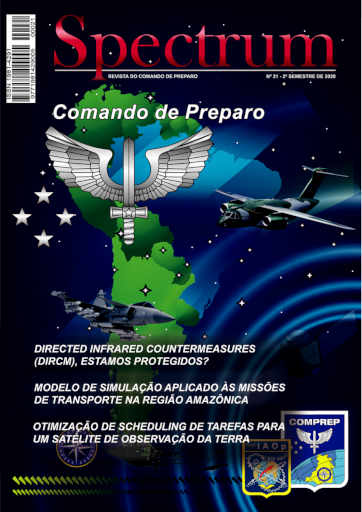Analysis of collision between space objects
Developing an algorithm to support in orbit satellite realoocation decision making
DOI:
https://doi.org/10.55972/spectrum.v21i1.76Keywords:
Collision Algorithms, Collision Avoidance, Space Debris, Collision RiskAbstract
Brazilian space operation has become more complex and robust. Although it is still below the great players, regarding technologies that mitigate catastrophes, like collisions. Due to space junk growth, in addition to the spread of technologies, such as constellations of nano and microsatellites, the number of objects in orbit has generated an increased threat number of collisions. Events of this magnitude can damage microsystems or even become a whole satellite inoperative, wasting time and financial investment, besides generating a greater number of debris in the collision, increasing in a cascade effect the likelihood of further collisions. Aiming to promote Brazilian independence in the segment technologies for space collision analysis, an algorithm for threat recognition and collision probability analysis is under development.
References
LEE, M. H.; MIN, C. O.; KIM, Y. S., LEE, D. W.; CHO, K. R. Analysis of population damage by space debris upon collision with Earth based on the reverse geocoding method. Aerospace Science and Technology, v. 50, p. 139–148, 2016.
CHEN, S. The Space Debris Problem. Asian Perspective, v. 35, p. 537–558, 2011.
KESSLER, D. J.; COUR-PALAIS, B. G. Collision frequency of artificial satellites - The creation of a debris belt. Journal of Geophysical Research, v. 83, n. A6, p. 2637–2646, 1978.
BRAUN, V.; FLOHRER, T.; KRAG, H.; MERZ, K.; LEMMENS, S.; BASTIDA VIRGILI, B.; FUNKE, Q. Operational support to collision avoidance activities by ESA’s space debris office. CEAS Space Journal, v. 8, n. 3, p. 177–189, 2016.
SCHILDKNECHT, T. Optical surveys for space debris. The Astronomy and Astrophysics Review, v. 14, n. 1, p. 41–111, 2007.
MIURA, N. Z. Comparison and Design of Simplified General Perturbation Models (SGP4) and Code for Nasa Johnson Space Center. Climate Change 2013 - The Physical Science Basis. Faculty of California Polytechnic State University, 2009.
LIN, M.; XU, M.; FU, X. A parallel algorithm for the initial screening of space debris collisions prediction using the SGP4/SDP4 models and GPU acceleration. Advances in Space Research, v.59, n. 9, p. 2398–2406, 2017.
SPACE-TRACK. Satellite Catalog. Space-Track.org. Disponível em < https://www.space-track.org/#/catalog >. Acesso em 11 mar. 2018.
LEWIS, H. Perigo em órbita: o avanço do problema do lixo espacial. BBC Brasil. 2015. Disponível em <http://www.bbc.com/portuguese/noticias/2015/08/150806_lixo_espacial_ab >. Acesso em 07 fev. 2018.
COYLE, D. B.; STYSLEY, P. R.; MCGARRY, J. F.; HULL, S. M.; GETZANDANNER, K. M.; YOUNG, P. Adapting a Ground-Based Laser Ranging System at NASA-GSFC for Identification and Tracking of Orbital Debris. In: Laser Radar Technology and Applications XVIII, v. 8731, n. 0F, 2013.
PATERA, R. P. General Method for Calculating Satellite Collision Probability. Journal of Guidance, Control and Dynamics, v. 24, n. 4, p. 716–722, 2001.
KLINKRAD, H. Collision risk analysis for low Earth orbits. Advances in Space Research, v. 13, n. 8, p. 177–186, 1993.
KAUSHIK, A. S. A statistical comparison between Gibbs and Herrick-Gibbs orbit determination methods. Texas A&M University, 2016.
DOLADO-PEREZ, J. C.; PARDINI, C.; ANSELMO, L. Review of uncertainty sources affecting the long-term predictions of space debris evolutionary models. Acta Astronautica, v. 113, p. 51–65, 2015.
AKELLA, M. R.; ALFRIEND, K. T. Probability of Collision Between Space Objects. Journal of Guidance, Control and Dynamics, v. 23, n. 5, p. 769 – 772, 2000.
XU, X.; XIONG, Y. A method for calculating probability of collision between space objects. Research in Astronomy and Astrophysics, v. 14, n. 5, p. 601–609, 2014.
HOOTS, F. R; CRAWFORD, L. L.; ROEHRICH, R. L. An analytic method to determine future close approaches between satellites. In: Celestial Mechanics, v. 33, p. 143–158, 1984.
HOOTS, F. R.; ROEHRICH, R. L.; KELSO, T. S. Spacetrack Report No. 3 - Models for Propagation of NORAD Elements Sets. Spacetrack Report, v. 3, p. 91, 1980. Disponível em < http://celestrak.com/NORAD/documentation/spacetrk.pdf >. Acesso em: 16 abr. 2016.
PETIT, A.; LEMAITRE, A. The impact of the atmospheric model and of the space weather data on the dynamics of clouds of space debris. Advances in Space Research, v. 57, n. 11, p. 2245–2258, 2016.
ALFANO, S. Satellite Collision Probability Enhancements. Journal of Guidance, Control, and Dynamics, v. 29, n. 3, p. 588–592, 2006.
Downloads
Published
How to Cite
Issue
Section
Categories
License
Copyright (c) 2020 Ilmo Caldas Neto, Henrique Costa Marques, Diego Geraldo

This work is licensed under a Creative Commons Attribution-NonCommercial-ShareAlike 4.0 International License.



